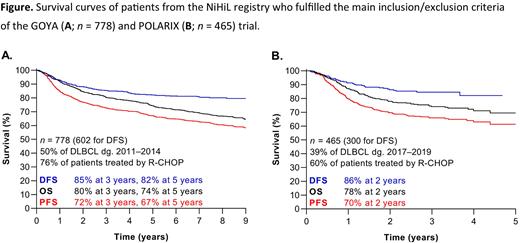Abstract
Background. The development of novel therapeutical strategies is essential for improvement of survival of patients with newly diagnosed diffuse large B-cell lymphoma (DLBCL). Almost all attempts to improve the outcome over R-CHOP have failed. The study cohort selection and its representativeness is one of the important questions which is repeatedly discussed. We have decided to compare the outcome of real-world data of R-CHOP-treated patients with control arms of two studies. First study is a negative one - GOYA trial (Vitolo, 2017) testing replacement of rituximab by obinutuzumab; and the second study is a positive one - POLARIX trial (Tilly, 2022) testing the substitution of vincristine by an antibody-drug conjugate polatuzumab vedotin. The aim of this analysis is to understand the relevance of the results of clinical trials for daily practice.
Methods. Characteristics and outcomes of patients in the control cohorts of the GOYA trial (n = 710) and POLARIX trial (n = 439) were compared retrospectively with cohorts of patients identified in the Czech national non-Hodgkin lymphoma registry NiHiL (NCT03199066) who fulfilled the main inclusion/exclusion criteria (IC/EC) of the respective studies and were treated in the recruitment period of each study.
Results. Altogether 4602 patients with de novo DLBCL, their characteristics and information on treatment and outcomes were identified in the NiHiL registry between 2008-2020. Of them, 1572 patients were diagnosed between years 2011-2014 and 1182 between 2017-2019.
From the cohort of 1572 patients diagnosed between 2011-2014, 1028 (65%) patients received R-CHOP, and 778 (50% of all and 76% of R-CHOP cohort) patients met all main IC/EC of the GOYA study. The patients (median age 64 years vs. 62 years in the control cohort of the GOYA trial) were diagnosed with advanced clinical stage (aCS) in 60% (vs. 76%), PS ECOG 2 in 21% (vs. 14%), elevated LDH 66% (vs. 57%), and IPI 3-5 in 49% (vs. 43%). The median time from diagnosis to treatment initiation was 25 days for both our patients and the GOYA control arm. A total of 82% of patients completed the planned ≥ 6 cycles of R-CHOP (vs. 85%). Our patients presented with similar ORR of 75% vs. 78% in the GOYA study (CR rate 69% vs. 59%), prolonged survival in terms of PFS (72% vs. 67% at 3 years, 67% vs. 63% at 5 years; Fig. A), and similar OS (80% vs. 81% at 3 years, 74% vs. 78% at 5 years), with median follow-up of 99.6 months (range 0.4-135.6).
Among the 1182 patients diagnosed between 2017-2019, a total of 773 (65%) patients were treated by R-CHOP, from which 465 patients (39% of all DLBCL and 60% of R-CHOP patients) met the IC/EC of the POLARIX study. Median age was 67 years (vs. 66 years in the control cohort of the POLARIX trial) aCS was observed in 76% (vs. 88%), PS ECOG 2 in 28% (vs. 17%), elevated LDH in 79% (vs. 65%), and IPI 3-5 in 64% (vs. 62%). The median time from diagnosis to treatment initiation was 29 days (vs. 27 days). Majority of patients (80%) received all the planned ≥ 6 cycles of R-CHOP (vs. 86%). Our patients had slightly decreased ORR in comparison to the POLARIX control cohort (76% vs. 84%; CR rate 63% vs. 74%). The PFS of both cohorts of patients was 70% at 2 years (Fig. B). But, the 2-year OS was inferior in the NiHiL control cohort (78% vs. 89%), with median follow-up time of 35.6 months (range 1.0-62.9).
Conclusions. The patients with newly diagnosed DLBCL in the real-life setting defined by the IC/EC of the study cohorts (GOYA, POLARIX) have similar primary endpoints outcomes as the control R-CHOP arms of those study cohorts. Thus, the study results are relevant for the daily practice. It has to be however taken into account that IC/EC defined cohorts represent only 76% (GOYA), and 60% (POLARIX) of all R-CHOP-treated patients in the real life.
Disclosures
Vodicka:Hoffmann-La Roche: Speakers Bureau. Belada:Gilead: Consultancy, Other: travel expenses; Roche: Consultancy, Other: travel expenses, Research Funding; Takeda: Consultancy, Other: travel expenses, Research Funding; Janssen-Cilag: Consultancy, Research Funding; Genmab: Research Funding; MorphoSys AG: Consultancy, Research Funding; Pharmacyclics: Research Funding; Reddy´s: Research Funding. Prochazka:Hoffmann-La Roche: Speakers Bureau; Takeda: Speakers Bureau; Novartis: Speakers Bureau. Duras:Celgene: Consultancy, Membership on an entity's Board of Directors or advisory committees; Bristol-Myers-Squibb: Consultancy, Membership on an entity's Board of Directors or advisory committees; Hoffmann-La Roche: Consultancy, Membership on an entity's Board of Directors or advisory committees; Takeda: Consultancy, Membership on an entity's Board of Directors or advisory committees. Kopeckova:Laboratoires Pierre Fabre: Current equity holder in private company; Novartis: Current equity holder in publicly-traded company, Honoraria; Viatris: Current equity holder in publicly-traded company; EISAI: Research Funding. Trneny:Takeda: Consultancy, Honoraria, Research Funding; AbbVie: Consultancy, Honoraria; Incyte: Consultancy, Honoraria; Bristol-Myers Squibb: Consultancy, Honoraria; Novartis: Consultancy, Honoraria, Research Funding; Zentiva: Consultancy, Honoraria; Morphosys: Consultancy, Honoraria; Janssen: Consultancy, Honoraria; Gilead Sciences: Consultancy, Honoraria; Hoffman-La Roche: Consultancy, Honoraria, Research Funding; Amgen: Consultancy, Honoraria.
Author notes
Asterisk with author names denotes non-ASH members.


